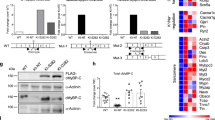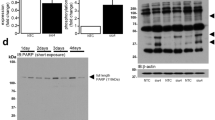Abstract
The serine-threonine kinase Akt/PKB mediates stimuli from different classes of cardiomyocyte receptors, including the growth hormone/insulin like growth factor and the β-adrenergic receptors. Whereas the growth-promoting and antiapoptotic properties of Akt activation are well established, little is known about the effects of Akt on myocardial contractility, intracellular calcium (Ca2+) handling, oxygen consumption, and β-adrenergic pathway. To this aim, Sprague–Dawley rats were subjected to a wild-type Akt in vivo adenoviral gene transfer using a catheter-based technique combined with aortopulmonary crossclamping. Left ventricular (LV) contractility and intracellular Ca2+ handling were evaluated in an isolated isovolumic buffer-perfused, aequorin-loaded whole heart preparations 10 days after the surgery. The Ca2+–force relationship was obtained under steady-state conditions in tetanized muscles. No significant hypertrophy was detected in adenovirus with wild-type Akt (Ad.Akt) versus controls rats (LV-to-body weight ratio 2.6±0.2 versus 2.7±0.1 mg/g, controls versus Ad.Akt, P, NS). LV contractility, measured as developed pressure, increased by 41% in Ad.Akt. This was accounted for by both more systolic Ca2+ available to the contractile machinery (+19% versus controls) and by enhanced myofilament Ca2+ responsiveness, documented by an increased maximal Ca2+-activated pressure (+19% versus controls) and a shift to the left of the Ca2+–force relationship. Such increased contractility was paralleled by a slight increase of myocardial oxygen consumption (14%), while titrated dose of dobutamine providing similar inotropic effect augmented oxygen consumption by 39% (P<0.01). Phospholamban, calsequestrin, and ryanodine receptor LV mRNA and protein content were not different among the study groups, while sarcoplasmic reticulum Ca2+ ATPase protein levels were significantly increased in Ad.Akt rats. β-Adrenergic receptor density, affinity, kinase-1 levels, and adenylyl cyclase activity were similar in the three animal groups. In conclusion, our results support an important role for Akt/PKB in the regulation of myocardial contractility and mechanoenergetics.
This is a preview of subscription content, access via your institution
Access options
Subscribe to this journal
Receive 12 print issues and online access
$259.00 per year
only $21.58 per issue
Buy this article
- Purchase on Springer Link
- Instant access to full article PDF
Prices may be subject to local taxes which are calculated during checkout








Similar content being viewed by others
References
Testa JR, Bellacosa A . Akt plays a central role in tumorigenesis. Proc Natl Acad Sci USA 2001; 98: 10983–10985.
Oh H, Fujio Y, Kunisada K, Hirota H, Matsui H, Kishimoto T et al. Activation of phosphatidylinositol 3-kinase through glycoprotein 130 induces protein kinase B and p70 S6 kinase phosphorylation in cardiac myocytes. J Biol Chem 1998; 273: 9703–9710.
Morisco C, Zebrowski DC, Vatner DE, Vatner SF, Sadoshima J . The Akt-glycogen synthase kinase 3beta pathway regulates transcription of atrial natriuretic factor induced by beta-adrenergic receptor stimulation in cardiac myocytes. J Biol Chem 2000; 275: 14466–14475.
Matsui T, Nagoshi T, Rosenzweig A . Akt and PI 3-kinase signaling in cardiomyocyte hypertrophy and survival. Cell Cycle 2003; 2: 220–223.
Shioi T, McMullen JR, Kang PM, Douglas PS, Obata T, Franke TF et al. Akt/protein kinase B promotes organ growth in transgenic mice. Mol Cell Biol 2002; 22: 2799–2809.
Yamashita K, Kajstura J, Discher DJ, Wasserlauf BJ, Bishopric NH, Anversa P et al. Reperfusion-activated Akt kinase prevents apoptosis in transgenic mouse hearts overexpressing insulin-like growth factor-1. Circ Res 2001; 88: 609–614.
Miao W, Luo Z, Kitsis RN, Walsh K . Intracoronary adenovirus-mediated Akt gene transfer in heart limits infarct size following ischemia–reperfusion injury in vivo. J Mol Cell Cardiol 2000; 32: 2397–2402.
Matsui T, Tao J, del Monte F, Lee KH, Li L, Picard M et al. Akt preserves cardiac function and prevents injury after transient cardiac ischemia in vivo. Circulation 2001; 104: 330–335.
Fujio Y, Nguyen T, Wencker D, Kitsis RN, Walsh K . Akt promotes survival of cardiomyocytes in vitro and protects against ischemia–reperfusion injury in mouse heart. Circulation 2000; 101: 660–667.
Condorelli G, Drusco A, Stassi G, Bellacosa A, Roncarati R, Iaccarino G et al. Akt induces enhanced myocardial contractility and cell size in vivo in transgenic mice. Proc Natl Acad Sci USA 2002; 99: 12333–12338.
Kim YK, Kim SJ, Yatani A, Huang Y, Castelli G, Vatner DE et al. Mechanisms of enhanced cardiac function in mice with hypertrophy induced by overexpressed Akt. J Biol Chem 2003; 278: 47622–47628.
Bonci D, Cittadini A, Latronico MV, Borello U, Aycock JK, Drusco A et al. ‘Advanced’ generation lentiviruses as efficient vectors for cardiomyocyte gene transduction in vitro and in vivo. Gene Therapy 2003; 10: 630–636.
Hajjar RJ, Schmidt U, Matsui T, Guerrero JL, Lee KH, Gwathmey JK et al. Modulation of ventricular function through gene transfer in vivo. Proc Natl Acad Sci USA 1998; 95: 5251–5256.
Ikeda Y, Gu Y, Iwanaga Y, Hoshijima M, Oh SS, Giordano FJ et al. Restoration of deficient membrane proteins in the cardiomyopathic hamster by in vivo cardiac gene transfer. Circulation 2002; 105: 502–508.
Camacho SA, Brandes R, Figueredo VM, Weiner MW . Ca2+ transient decline and myocardial relaxation are slowed during low flow ischemia in rat hearts. J Clin Invest 1994; 93: 951–957.
Blinks JR, Endoh M . Modification of myofibrillar responsiveness to Ca2+ as an inotropic mechanism. Circulation 1986; 73: III85–III98.
Perrault CL, Meuse AJ, Bentivegna LA, Morgan JP . Abnormal intracellular calcium handling in acute and chronic heart failure: role in systolic and diastolic dysfunction. Eur Heart J 1990; 11: 8–21.
Wisloff U, Loennechen JP, Falck G, Beisvag V, Currie S, Smith G et al. Increased contractility and calcium sensitivity in cardiac myocytes isolated from endurance trained rats. Cardiovasc Res 2001; 50: 495–508.
Wisloff U, Loennechen JP, Currie S, Smith GL, Ellingsen O . Aerobic exercise reduces cardiomyocyte hypertrophy and increases contractility, Ca2+ sensitivity and SERCA-2 in rat after myocardial infarction. Cardiovasc Res 2002; 54: 162–174.
Beanlands RS, Bach DS, Raylman R, Armstrong WF, Wilson V, Montieth M et al. Acute effects of dobutamine on myocardial oxygen consumption and cardiac efficiency measure using carbon-11 acetate kinetics in patients with dilated cardiomyopathy. J Am Coll 1993; 22: 1389–1398.
Hasenfuss G, Holubarsch C, Heiss HW, Meinertz T, Bonzel T, Wais U et al. Myocardial energetics in patients with dilated cardiomyopathy: influence of nitroprusside and enoximone. Circulation 1989; 80: 51–64.
Saccà L, Cittadini A, Fazio S . Growth hormone and the heart. Endocr Rev 1994; 15: 555–573.
Cittadini A, Ishiguro Y, Stromer H, Spindler M, Moses AC, Clark R et al. Insulin-like growth factor-1 but not growth hormone augments mammalian myocardial contractility by sensitizing the myofilament to Ca2+ through a wortmannin-sensitive pathway. Studies in rat and ferret isolated muscles. Circ Res 1998; 83: 50–59.
Tajima M, Weinberg EO, Bartunek J, Jin H, Yang R, Paoni NF et al. Treatment with growth hormone enhances contractile reserve and intracellular calcium transients in myocytes from rats with postinfarction heart failure. Circulation 1999; 99: 127–134.
He H, Giordano FJ, Hilal-Dandan R, Choi DJ, Rockman HA, McDonough PM et al. Overexpression of the rat sarcoplasmic reticulum Ca2+-ATPase gene in the heart of transgenic mice accelerates calcium transients and cardiac relaxation. J Clin Invest 1997; 100: 380–389.
Baker DL, Hashimoto K, Grupp IL, Ji Y, Reed T, Loukianov E et al. Targeted overexpression of the sarcoplasmic reticulum Ca2+-ATPase increases cardiac contractility in transgenic mouse hearts. Circ Res 1998; 83: 1205–1214.
Duan J, Zhang HY, Adkins SD, Ren BH, Norby FL, Zhang X et al. Impaired cardiac function and IGF-I response in myocyte from calmodulin-diabetic mice: role of Akt and RhoA. Am J Physiol 2003; 284: E366–E376.
Haq S, Choukroun G, Lim H, Tymitz KM, del Monte F, Gwathmey J et al. Differential activation of signal transduction pathways in human hearts with hypertrophy versus advanced heart failure. Circulation 2001; 103: 670–677.
Taniyama Y, Walsh K . Elevated myocardial Akt signaling ameliorates doxorubicin-induced congestive heart failure and promotes heart growth. J Moll Cell Cardiol 2002; 34: 1241–1247.
Iaccarino G, Ciccarelli M, Sorriento D, Cipolletta E, Cerullo V, Iovino GL et al. Akt participates to endothelial dysfunction in hypertension. Circulation 2004; 109: 2587–2593.
Claudio PP, Fratta L, Farina F, Howard CM, Stassi G, Numata S et al. Adenoviral RB2/p130 gene transfer inhibits smooth muscle cell proliferation and prevents restenosis after angioplasty. Circ Res 1999; 85: 1032–1039.
Cittadini A, Stromer H, Katz SE, Clark R, Moses AC, Morgan JP et al. Differential cardiac effects of GH and IGF-1 in the rat: a combined in vivo and in vitro evaluation. Circulation 1996; 93: 800–809.
Kihara Y, Grossman W, Morgan JP . Direct measurement of changes in intracellular calcium transients during hypoxia, ischemia and reperfusion of the intact mammalian heart. Circ Res 1989; 65: 1029–1044.
Brooks WW, Healey NA, Sen S, Conrad CH, Bing OH . Oxygen cost of stress development in hypertrophied and failing hearts from the spontaneously hypertensive rat. Hypertension 1993; 21: 56–64.
Nelson GS, Berger RD, Fetics BJ, Talbot M, Spinelli JC, Hare JM et al. Left ventricular or biventricular pacing improves cardiac function at diminished energy cost in patients with dilated cardiomyopathy and left bundle-branch block. Circulation 2000; 102: 3053–3059.
Callies F, Stromer H, Schwinger RH, Bolck B, Hu K, Frantz S et al. Administration of testosterone is associated with a reduced susceptibility to myocardial ischemia. Endocrinology 2003; 144: 4478–4483.
Chomczynski P, Sacchi N . Single step method of RNA isolation by acidic guanidinium thiocyanate–phenol–chloroform extraction. Anal Biochem 1987; 162: 156–159.
Temsah RM, Dyck C, Netticadan T, Chapman D, Elimban V, Dhalla NS . Effect of β-adrenoreceptor blockers on sarcoplasmatic reticular function and gene expression in the ischemic reperfused heart. J Pharmacol Exp Ther 2000; 293: 15–23.
Iaccarino G, Barbato E, Cipolletta E, Esposito A, Fiorillo A, Koch WJ et al. Cardiac βARK1 upregulation induced by chronic salt deprivation in rats. Hypertension 2001; 38: 255–260.
Acknowledgements
This work was supported in part by grants from the Italian National Institute of Health, The Italian Ministy of Education (MIUR), and Adriano Buzzati-Traverso Foundation.
Author information
Authors and Affiliations
Corresponding author
Additional information
Presented in part at the Annual La Jolla-Kyoto-Horizons on heart failure, La Jolla, CA, December 16–19, 2002.
Rights and permissions
About this article
Cite this article
Cittadini, A., Monti, M., Iaccarino, G. et al. Adenoviral gene transfer of Akt enhances myocardial contractility and intracellular calcium handling. Gene Ther 13, 8–19 (2006). https://doi.org/10.1038/sj.gt.3302589
Received:
Revised:
Accepted:
Published:
Issue Date:
DOI: https://doi.org/10.1038/sj.gt.3302589
Keywords
This article is cited by
-
PI3K/Akt pathway mediates the positive inotropic effects of insulin in Langendorff-perfused rat hearts
Scientific Reports (2022)
-
Local anesthetic systemic toxicity: proposed mechanisms for lipid resuscitation and methods of prevention
Journal of Anesthesia (2019)
-
β3-adrenoceptor impacts apoptosis in cultured cardiomyocytes via activation of PI3K/Akt and p38MAPK
Journal of Huazhong University of Science and Technology [Medical Sciences] (2016)



